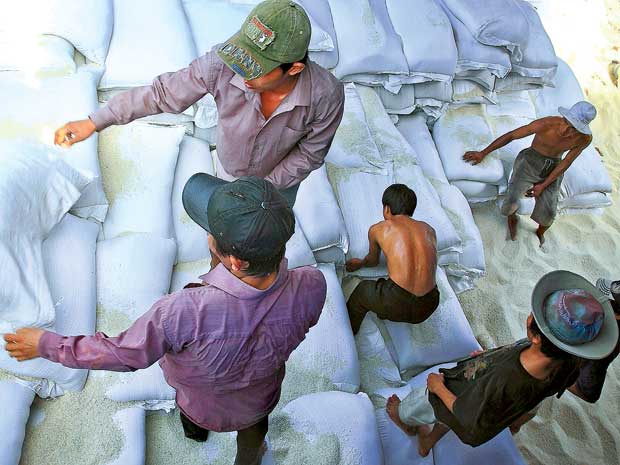VietNamNet Bridge – The decision by the Vietnam Food Association (VFA) to halt
the purchase of one million tons of summer-autumn rice since July 15, has made
the rice price decrease in Mekong Delta and made farmers worried.

Exporters stop collecting rice, waiting for the prices to go down
Small merchants, who collect rice from farmers to provide to export companies,
said that exporters now purchase rice in dribs and drabs. “Many private trucks
have come here from Can Tho, Tien Giang and Vinh Long to collect rice, while
export companies only purchase rice at moderate level,” said Sau Tho, a small
merchant in Thoai Son district in An Giang province.
Explaining the decision to stop collecting rice, VFA said that the current rice
prices are now high enough to ensure profits for farmers.
It is now the rush time for farmers in Mekong Delta to harvest the summer-autumn
rice. It is expected that 2 million tons of rice needs to be put into
transactions by October.
Sources from export companies said that if the domestic rice prices keep rising,
they would incur losses with the export contracts they signed in May and June at
low export prices. According to VFA, exporters will have to deliver 1.3 million
tons of rice in July to fulfill the contracts signed in May and June.
In May and June, the rice prices dropped to the lowest peaks in the year. Thai 5
percent broken rice dropped from 530 dollars per ton in January to 470 dollars
in May. However, the escalation of the domestic rice price will surely make
exporters incur loss. If they purchase rice at this moment, the cost prices
would be 20-30 dollars per ton higher than the contracted prices.
The demand from China remains an unknown
A question has been raised that if the rice prices would go down once VFA’s
member companies stop purchasing rice.
Businessmen said that they can see similar conditions in the markets in 2011 and
in 2010. In 2010, the rice price increased, but it was not because of the high
purchasing demand from Vietnamese export companies, but from the high demand
from China.
In July 2010, VFA estimated that 600,000 tons or summer-autumn rice was carried
by land and by sea to China across the border. This led to the sharp increases
of rice price on the domestic market.
As a result, export companies incurred a big loss of 25-30 dollars per ton, when
they signed export contracts at less than 300 dollars a ton for 25 percent
broken rice and 340-350 dollars per ton for five percent broken rice.
The same thing is occurring now, but difficulties have only been put for small
enterprises, who do not have big capital and only begin collecting rice after
they signed contracts with foreign partners. Meanwhile, big export companies
have collected enough rice to fulfill the orders.
By the end of June 2011, the stocks of the Northern and Southern Food
Corporations had reached 134,000 tons and 420,000 tons, respectively.
“Every day I purchase 30 tons of rice, then husk and sell to private
enterprises,” said Vuong Tai Hien, a small merchant in An Giang province. Hien
believes that the rice prices would resume the upward trend in several days
after the VFA’s announcement, because businessmen now need to collect rice.
Sources say that Chinese businessmen are seeking to purchase Vietnamese rice in
the name of Vietnamese merchants. VFA has also said that China has never
admitted the rice import. However, some of its provinces regularly have to buy
rice from neighboring countries, including Vietnam.
Source: SGTT
- © Copyright of Vietnamnet Global.
- Tel: 024 3772 7988 Fax: (024) 37722734
- Email: evnn@vietnamnet.vn